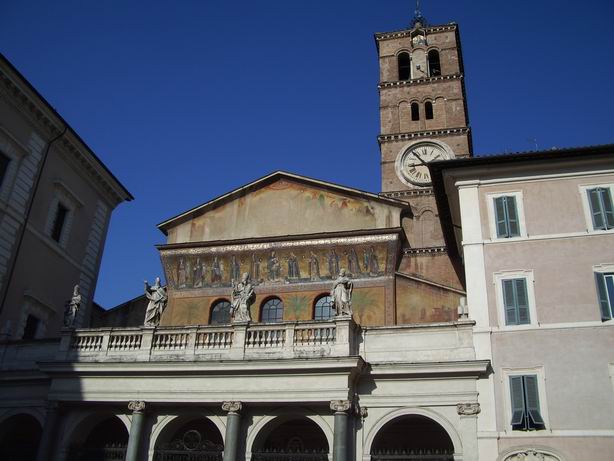|
|
 |
|
S. Maria in Trastevere |
|
written
by ars7 / 10.06.2004 |
|
|
| |
Introduction |
| |
| |

|
| Anna |
| S. Maria in Trastevere |
|
| |
|
The church of S. Maria in Trastevere is located in the heart of the Trastevere neighborhood, near Ponte Sisto. There have been religious meetings on this site for almost two thousand years; early Christians had a legend that an oil spring (fons olei) issued from the ground at this spot and flowed all the way to the Tiber, making this spot portentous. Pope St. Julius I built a church of this name here shortly after the time of Constantine, making it one of the oldest churches dedicated to Maria. The structure that exists today is not St. Julius’s basilica, though. Pope Innocent II tore down that building in 1140 and replaced it with his own, which (with a few renovations) is what one can visit today.
Pope Innocent II was born Gregorio Papereschi, a member of a rich and influential Italian family. At the papal election in early 1130, he got the minority of the vote of the College of Bishops, while his rival Anacletus II got the majority, creating a schism in the Catholic Church. Innocent fled to France, where he was confirmed as the rightful pope at the Synod of Etampes in late 1130, but Anacletus held sway over Rome. Innocent had significant support throughout Europe, especially in France and in the Holy Roman Empire—in the following years he presided over the crowning of the monarchs of both countries, and he was friends with Abbot Suger of St. Denis. In 1133 the Holy Roman Empire went so far as to invade Italy to assist Innocent in reaching the papal throne, but the operation was not able to oust Anacletus. Anacletus died in 1138 and the College of Bishops elected Victor IV to replace him. Victor was not as tenacious as Anacletus, though, and Innocent was able to persuade him to back down and let Innocent assume the papacy. The 10th Ecumenical Council, in 1139, finally laid the dispute to rest by declaring all of Anacletus’s acts to be null and reaffirming Innocent’s authority. Shortly after the Council, in 1140, Innocent started reconstruction of S. Maria in Trastevere as a demonstration of power. S. Maria in Trastevere was chosen because Anacletus had been the bishop of this church, and erasing his church was an important strategic step in erasing his memory.
|
| |
|
| |
|
|
 |
|
